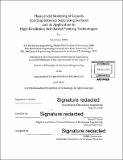Phase-field modeling of liquids splitting between separating surfaces and its application to high-resolution roll-based printing technologies
Author(s)
Hizir, Fahri Erinc
DownloadFull printable version (18.03Mb)
Other Contributors
Massachusetts Institute of Technology. Department of Mechanical Engineering.
Advisor
David E. Hardt.
Terms of use
Metadata
Show full item recordAbstract
In roll-based printing systems, controlled release of liquid ink to the substrate surface is achieved through the transport of the liquid ink through a series of ink transfer rollers in the form of splitting liquid bridges. An in-depth understanding of the liquid transport process through the ink transfer rollers is essential for advancing the roll-based printing technology and achieving the highest quality printing. In this study, the phase-field method is investigated to characterize the liquid bridges in roll-based printing systems. Phase-field models of two-phase flow systems are being used increasingly often in a variety of applications ranging from microfluidics to turbulent flows. However, there are limited implementations of the phase-field method to simulate the liquid ink transport in roll-based printing systems. There are advantages of the phase-field method over other methods that are generally used for simulating the liquid transport in roll-based printing systems such as the volume of fluid method and the moving mesh methods. This study demonstrates that the phase-field method is an effective tool to simulate the liquid ink transport in roll-based printing systems that facilitates the treatment of certain characteristics of the ink flows such as moving and deforming interfaces, topology changes, and slipping contact lines. In the phase-field simulations described in this study, the liquid ink transport between the rollers is approximated as the stretching and splitting of liquid bridges with pinned or moving contact lines between vertically separating surfaces. The interface separating the liquid and the surrounding air is represented as a diffuse interface with finite thickness across which the two phases mix. First, the simulation conditions that yield accurate results are determined by examining the effect of the phase-field parameters and the mesh characteristics on the simulation results. The simulation results show that a sharp interface limit is approached when the capillary width is decreased keeping the mobility proportional to the capillary width squared. This limit best represents real interfaces having molecular thickness in the micron-scale flows investigated. Close to the sharp interface limit, the mobility changes over a specified range are observed to have no significant influence on the simulation results. The computational mesh is segmented into regions of varying mesh fineness or adaptive mesh refinement is implemented to reduce the computational cost of resolving thin interfaces in the simulations. The simulation results are validated against data reported in existing studies of liquid ink transport in roll-based printing systems for selected capillary width and mobility values. Next, the liquid ink transport from the axisymmetric cells on the surface an ink-metering roller to the surface of stamp features is simulated. The function of the cells on an ink-metering roller is to control the amount of liquid ink delivered to the stamp surface. The resolution of printing is limited by the width of the cell openings, since uniform inking of the stamp requires the width of the cell openings to be smaller than the size of the stamp features. The cell geometries explored in the simulations are selected to enable printing with higher resolution than the current industry standards. Increasing the resolution of printing would improve the performance of printed products and expand their range of functionality. The results of the simulations indicate that under negligible inertial effects and in the absence of gravity, the amount of liquid ink transferred from a cell with low surface wettability to a stamp with high surface wettability increases as the cell sidewall steepness and the cell surface wettability decrease, and the stamp surface wettability and the capillary number increase. The amount of liquid ink removed from the cell does not change significantly as the cell depth increases above a certain value. High-resolution printing strategies, which indicate how the printing parameters should be manipulated to more precisely control the printed layer thickness, to eliminate printing defects, and to minimize cell clogging, are derived by analyzing the simulation results. The cells with different sidewall inclination angles are used to represent the cells with irregular surface topography on novel materials and novel roller designs that could be used for stamp inking during high-resolution roll-based printing, such as the pores on porous materials and the cells fabricated with poor control over cell geometry due to manufacturing difficulties at small length scales. The variations in the printed layer thickness with the cell sidewall inclination angle is found to be significant (~10-100 nm for cells with 2-[mu]m opening width) indicating that the variations in cell geometry should be minimized when designing advanced rollers for use in high-resolution roll-based printing.
Description
Thesis: Ph. D., Massachusetts Institute of Technology, Department of Mechanical Engineering, 2016. Cataloged from PDF version of thesis. Includes bibliographical references (pages ).
Date issued
2016Department
Massachusetts Institute of Technology. Department of Mechanical EngineeringPublisher
Massachusetts Institute of Technology
Keywords
Mechanical Engineering.